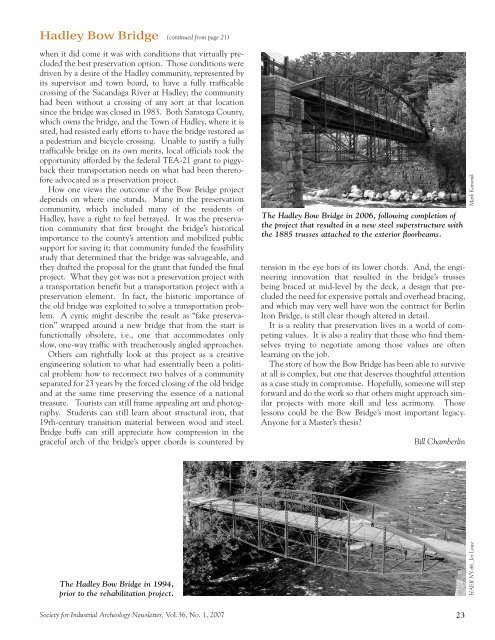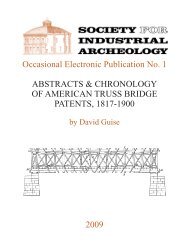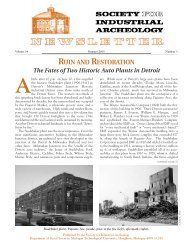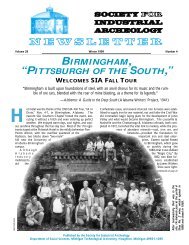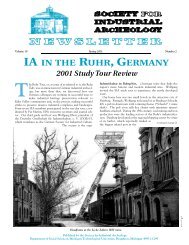SIAN - Society for Industrial Archeology
SIAN - Society for Industrial Archeology
SIAN - Society for Industrial Archeology
Create successful ePaper yourself
Turn your PDF publications into a flip-book with our unique Google optimized e-Paper software.
Hadley Bow Bridge (continued from page 21)when it did come it was with conditions that virtually precludedthe best preservation option. Those conditions weredriven by a desire of the Hadley community, represented byits supervisor and town board, to have a fully trafficablecrossing of the Sacandaga River at Hadley; the communityhad been without a crossing of any sort at that locationsince the bridge was closed in 1983. Both Saratoga County,which owns the bridge, and the Town of Hadley, where it issited, had resisted early ef<strong>for</strong>ts to have the bridge restored asa pedestrian and bicycle crossing. Unable to justify a fullytrafficable bridge on its own merits, local officials took theopportunity af<strong>for</strong>ded by the federal TEA-21 grant to piggybacktheir transportation needs on what had been thereto<strong>for</strong>eadvocated as a preservation project.How one views the outcome of the Bow Bridge projectdepends on where one stands. Many in the preservationcommunity, which included many of the residents ofHadley, have a right to feel betrayed. It was the preservationcommunity that first brought the bridge’s historicalimportance to the county’s attention and mobilized publicsupport <strong>for</strong> saving it; that community funded the feasibilitystudy that determined that the bridge was salvageable, andthey drafted the proposal <strong>for</strong> the grant that funded the finalproject. What they got was not a preservation project witha transportation benefit but a transportation project with apreservation element. In fact, the historic importance ofthe old bridge was exploited to solve a transportation problem.A cynic might describe the result as “fake preservation”wrapped around a new bridge that from the start isfunctionally obsolete, i.e., one that accommodates onlyslow, one-way traffic with treacherously angled approaches.Others can rightfully look at this project as a creativeengineering solution to what had essentially been a politicalproblem: how to reconnect two halves of a communityseparated <strong>for</strong> 23 years by the <strong>for</strong>ced closing of the old bridgeand at the same time preserving the essence of a nationaltreasure. Tourists can still frame appealing art and photography.Students can still learn about structural iron, that19th-century transition material between wood and steel.Bridge buffs can still appreciate how compression in thegraceful arch of the bridge’s upper chords is countered byThe Hadley Bow Bridge in 1994,prior to the rehabilitation project.The Hadley Bow Bridge in 2006, following completion ofthe project that resulted in a new steel superstructure withthe 1885 trusses attached to the exterior floorbeams.tension in the eye bars of its lower chords. And, the engineeringinnovation that resulted in the bridge’s trussesbeing braced at mid-level by the deck, a design that precludedthe need <strong>for</strong> expensive portals and overhead bracing,and which may very well have won the contract <strong>for</strong> BerlinIron Bridge, is still clear though altered in detail.It is a reality that preservation lives in a world of competingvalues. It is also a reality that those who find themselvestrying to negotiate among those values are oftenlearning on the job.The story of how the Bow Bridge has been able to surviveat all is complex, but one that deserves thoughtful attentionas a case study in compromise. Hopefully, someone will step<strong>for</strong>ward and do the work so that others might approach similarprojects with more skill and less acrimony. Thoselessons could be the Bow Bridge’s most important legacy.Anyone <strong>for</strong> a Master’s thesis?Bill ChamberlinHAER NY-46, Jet Lowe Mark Kanonik<strong>Society</strong> <strong>for</strong> <strong>Industrial</strong> <strong>Archeology</strong> Newsletter, Vol.36, No. 1, 2007 23


